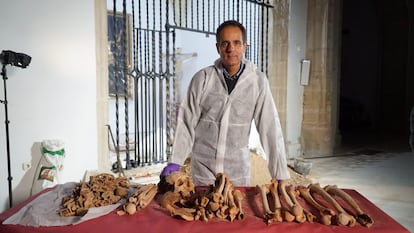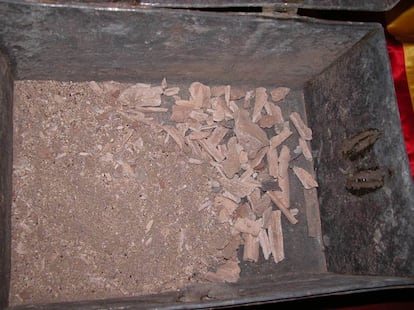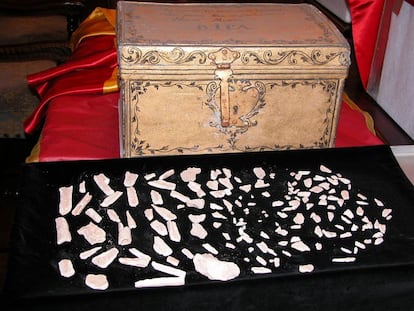Scientists cast doubt on claims Christopher Columbus was a Sephardic Jew from Spain
Specialists criticize the absence of scientific evidence in the RTVE documentary featuring forensic expert José Antonio Lorente, who has not published any analysis since the exhumation in 2003 of the alleged tomb of the explorer

The excitement surrounding the supposed origins of Christopher Columbus has generated astonishment in the scientific community. The documentary Columbus DNA. His True Origin, broadcast on Spain’s National Holiday suggests that the explorer was not Genoese and Christian but Spanish and Jewish. The absolute protagonist of the documentary, forensic scientist José Antonio Lorente, has not yet published any scientific study to back his claims.
The documentary is presented in the style of a reality show in which Lorente systematically discounts other theories, including that Columbus was Castilian, Portuguese, Galician, Mallorcan or a Cagot. It culminates with a scene in which only one possibility remains, the one put forward by architect Francesc Albardaner, author of the book La catalanitat de Colom (or, The Catalonian Origins of Columbus).
Lorente meets Albardaner, who is seriously ill with acute myeloblastic leukemia, in a garden, soundtracked by moving violin music. “I’m afraid of dying without finishing a theory I’ve been working on for many years,” says Albardaner.
Lorente, professor of Legal and Forensic Medicine at the University of Granada in Spain is reassuring.
– I should tell you that all the theories about Columbus being the son of so-and-so have all been discarded.
–What about mine?
–Regarding yours, I’m overjoyed to be able to tell you that it is the closest to the truth.
Albardaner then explains his theory: “Columbus was a Sephardic Jew, following Jewish traditions and customs. He had Jewish teachers who taught him the Jewish religion, but apparently in the public sphere, he was a Christian. According to my theory, he was born into a family of silk weavers in [the Spanish city of] Valencia, where there was a long tradition of silk weaving within the Jewish community.”
But geneticist Antonio Alonso, former chief of the National Institute of Toxicology and Forensic Sciences, is not convinced: “Unfortunately, from the scientific point of view, no assessment can be made after watching the documentary, since it does not provide any data on what has been analyzed. My conclusion is that the documentary Columbus DNA does not show the DNA of Columbus at any given moment and scientists do not know what analysis has been undertaken.”
The background to the documentary involves a high school teacher from the Sevillian town of Estepa, Marcial Castro, who approached Lorente’s laboratory in 2001 to suggest that they analyze the DNA of the supposed remains of Christopher Columbus in the Cathedral of Seville where he had lain since 1899. Lorente’s team obtained permits and in 2003 exhumed the presumed tomb of the explorer and also the tomb of his son Hernando which lay alongside it. The remains found in both graves were solemnly draped with the Spanish flag in front of dozens of journalists. Also rescued were the supposed remains of Diego Columbus, Christopher’s brother, found in a tin can filled with water in an earthenware factory set up in a former Carthusian monastery in Seville.
Forensic anthropologist Miguel Botella, also from the University of Granada, remembers that day in 2003 when he waited for the box containing the supposed bones of Christopher Columbus to be opened. “Everyone expected to be greeted by an intact Columbus, but there were only 150 grams of bone fragments,” he says with a smile. The largest would have been about four centimeters in length.

Botella analyzed the jumble of bones for six days with laser scanners. But the only thing he could be sure of was that all the remains belonged to the same person: a man between 50 and 70 years old — closer to 60 — and that there was a mark indicating that he had been eaten away. “I guess this was when they moved him from Valladolid to Seville,” he explains, referring to one of the numerous journeys of the supposed remains of Christopher Columbus, which traveled from Valladolid, where he died in 1506, to Seville three years later, to the Caribbean city of Santo Domingo in 1544, to Havana in Cuba in 1795 and back to Seville in 1899. By the time the bones were exhumed in 2003, it was not possible to extract DNA from the bones, Botella explains, adding that he stopped collaborating with the team responsible for the investigation after his initial involvement, not wishing to participate further.
Lorente then said that he was going to analyze the DNA of the three alleged members of the Columbus family with the help of prestigious geneticists, such as Ángel Carracedo from the University of Santiago de Compostela; and Mark Stoneking, from the Max Planck Institute for Evolutionary Anthropology, in Leipzig, Germany, one of the world’s most prestigious centers for the analysis of ancient DNA.
Carracedo recalls that the DNA that reached him was tremendously degraded, and he too distanced himself from the project. Moreover, he refuses to comment on Lorente’s new results until there is a serious scientific study published in a specialized journal. The response of the Max Planck Institute geneticist to questions from EL PAÍS were similar: “I am sorry, my group stopped working on this in 2005 and I have not heard anything about the most recent results,” said Stoneking.
Lorente attempts to justify his decision not to publish anything on his work for more than 20 years. “The study on Christopher Columbus and his family has always been considered a unit, as something joint and inseparable by our university and our team, and until the research is completed, nothing will be published,” he told EL PAÍS. In his opinion, Columbus DNA, directed by journalist Regis Francisco López, “is not a scientific documentary, but a film” based on his studies. The scientific results, he says, will be presented at a press conference probably at the end of November. Until then, Lorente says he will not issue any statements.
Despite the extreme degradation of the DNA, the forensic scientist already said back in 2006 that there was “no doubt” that the bones in Seville Cathedral belonged to the explorer who discovered the New World. Lorente did not provide any proof, but his assertion made headlines around the world. The U.S. network NBC News declared: “DNA verifies Columbus’ remains in Spain.”
Lorente explained in 2007 that the key lay in mitochondrial DNA, a small fragment that comes down the maternal line. “In the studies to identify Christopher Columbus to date, we have tried to answer two main questions: one, where his bones are, and two, where he was from,” said Lorente in the journal Medicina Balear. “The first question already has a definitive answer, because, after comparing the mitochondrial DNA of Columbus’ bones in Seville Cathedral with the DNA of the bones of his brother Diego, it has been observed that both are identical — typical of people with the same mother.”
Lorente later acknowledged, in a 2010 publication, that the mitochondrial DNA fragments obtained were “very small” — too small in fact to draw conclusions from. Now the documentary Columbus DNA states that the supposed remains of Christopher and Diego are not like those of two brothers, but of two second cousins.

According to geneticist Antonio Alonso, “It is not the done thing for data that the scientific community has not yet endorsed to be presented to society, as it puts the data itself at risk as well as the proposed theory.” Alonso is also surprised by the absence of experts from the U.S. and Australia in the film whose contribution Lorente describes as essential. “Here there is too much protagonism from only one scientist. Neither the Granada team nor the collaborating ancient DNA laboratories in California and Adelaide, which are said to be of great importance in the success of the analyses, appear in the film,” he points out.
Recently retired, Alonso is one of Spain’s leading experts in forensic genetics. He worked on the identification of the victims of Madrid’s 11-M terror attacks; on the investigation of dozens of reports of alleged baby thefts; on the recognition of Spanish Civil War victims and even on the attempts to find the remains of the writer Miguel de Cervantes. He claims that the documentary Columbus DNA does not speak to him as a scientist. “We do not know which DNA regions were analyzed, nor the technology used in the analysis, nor the results obtained, which makes it impossible to make a correct assessment of the findings,” he says.
In the documentary, Lorente tells Francesc Albardaner, “We have very partial DNA of Christopher Columbus, but it is enough, and we have DNA of Hernando Columbus, who is confirmed to be his son [...] What is very important in your theory is that both in the Y chromosome [inherited from the father] and in the mitochondrial DNA [inherited from the mother] of Hernando there are traits compatible with a Jewish origin.”
Alonso explains that there are clusters of genetic variants called haplotypes or haplogroups that tend to be inherited together and may be characteristic of certain family lineages, but he adds that they often coincide with those of other groups in historically Jewish or non-Jewish populations. “In any case, having a genealogy, a haplogroup or a haplotype of Jewish or Sephardic ancestry does not call into question Columbus’ birthplace in Genoa as stated by historical sources, nor does it tell us anything about the religious beliefs professed by the generations of relatives close to Columbus,” he says.
Rodrigo Barquera is a Mexican expert in archeogenetics at the Max Planck Institute for Evolutionary Anthropology. Barquera has conducted DNA studies of human remains prior to the arrival of Europeans in America, such as those of children sacrificed by the Maya at Chichén-Itzá in Mexico. The researcher is very critical of the fact the data have been presented via a documentary, and without the backing of a serious scientific article reviewed by independent experts, especially given the enormous interest in the figure of Christopher Columbus and his origins.
“Normally, the article is sent to a scientific journal,” he says. “The journal assigns an editor and at least three independent reviewers who rate the paper and decide if it is scientifically valid. If it is, it is published, and then the rest of the scientific community can say whether they agree or not. Putting it on a screen, removed from this process and with all the media focus on it, makes it difficult for the scientific community to say anything about it.”
Unaware of this fresh controversy, the Spanish Biographical Dictionary of the Royal Academy of History continues to offer the official version. In the entry dedicated to Christopher Columbus, the historian Juan Pérez de Tudela y Bueso, who died in 2004, objected to the “emotional rather than reasoned patriotism” that was required “to complete the Spanish glory of the discovery, making its protagonist a Spaniard.” In his opinion, “the first requirement to Spanishize the explorer is to disqualify the sources closest to his life as pure fake.”
According to Pérez de Tudela y Bueso, who was a professor of Modern History at the Complutense University of Madrid, “There were many scholars who tried to find Columbus’ birthplace in the Iberian Peninsula. [...] We should also note the efforts of Salvador de Madariaga [a diplomat and author of the biography Christopher Columbus in 1939] to place Columbus in the bosom of a family of Jewish converts. But these efforts are undermined by an indisputable argument — the testimonies of that period, including that of the explorer himself in the founding document of the estate in favor of his son Diego, are unanimous in establishing Genoa as the Colombus family seat. Genoese researchers have also reliably proven that Columbus was the son of Doménico Colombus and Susana Fontanarosso, both from Ligurian families dedicated to textile manufacturing.”
Antonio Salas heads the Population Genetics in Biomedicine team at Santiago de Compostela’s Health Investigation Institute. “The documentary promised to focus on DNA analysis, as suggested by its title Columbus DNA: His True Origins,” he says. “However, the genetic information it offers is very limited. Only at the end is it mentioned that the only thing that was recovered from the presumed remains of Christopher Columbus was a partial profile of the Y chromosome. The problem is that the Y chromosome represents only a tiny fraction of our DNA and our ancestry.”
“The documentary rushes to a conclusion that Christopher Columbus was a Sephardic Jew originally from the Spanish Levant. This hypothesis is, to say the least, surprising: there is no Y chromosome that can be uniquely defined as Sephardic-Jewish,” argues Salas. “Even if all of an individual’s DNA were recovered, it would still be impossible to reach definitive conclusions about his or her exact geographic origin.
The renowned geneticist Mark Jobling put it like this: “The best answer to the question ‘Where did my ancestors live?’ would be ‘Everywhere.’”
Sign up for our weekly newsletter to get more English-language news coverage from EL PAÍS USA Edition
Tu suscripción se está usando en otro dispositivo
¿Quieres añadir otro usuario a tu suscripción?
Si continúas leyendo en este dispositivo, no se podrá leer en el otro.
FlechaTu suscripción se está usando en otro dispositivo y solo puedes acceder a EL PAÍS desde un dispositivo a la vez.
Si quieres compartir tu cuenta, cambia tu suscripción a la modalidad Premium, así podrás añadir otro usuario. Cada uno accederá con su propia cuenta de email, lo que os permitirá personalizar vuestra experiencia en EL PAÍS.
¿Tienes una suscripción de empresa? Accede aquí para contratar más cuentas.
En el caso de no saber quién está usando tu cuenta, te recomendamos cambiar tu contraseña aquí.
Si decides continuar compartiendo tu cuenta, este mensaje se mostrará en tu dispositivo y en el de la otra persona que está usando tu cuenta de forma indefinida, afectando a tu experiencia de lectura. Puedes consultar aquí los términos y condiciones de la suscripción digital.
More information
Archived In
Últimas noticias
Reinhard Genzel, Nobel laureate in physics: ‘One-minute videos will never give you the truth’
Pinochet’s victims grapple with José Antonio Kast’s rise in Chile
From digital curfews to blocking apps: How technology experts protect their children online
Why the price of coffee has skyrocketed: from Brazilian plantations to specialty coffee houses
Most viewed
- Pablo Escobar’s hippos: A serious environmental problem, 40 years on
- Why we lost the habit of sleeping in two segments and how that changed our sense of time
- Trump’s obsession with putting his name on everything is unprecedented in the United States
- Charles Dubouloz, mountaineering star, retires at 36 with a farewell tour inspired by Walter Bonatti
- The Florida Keys tourist paradise is besieged by immigration agents: ‘We’ve never seen anything like this’










































